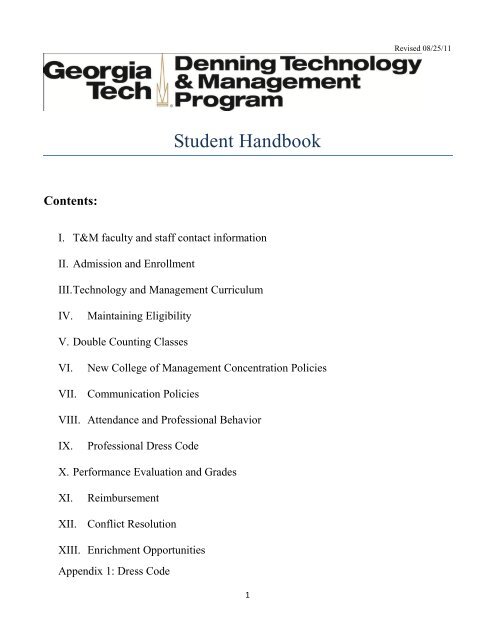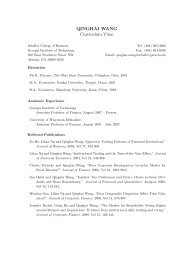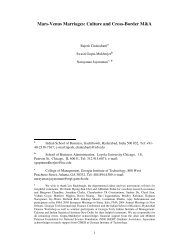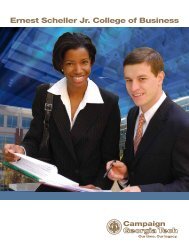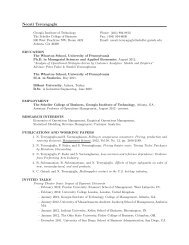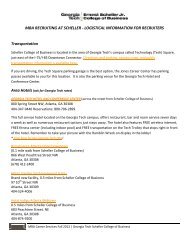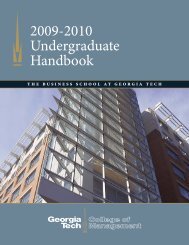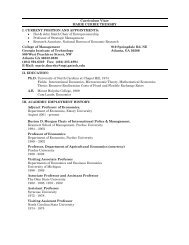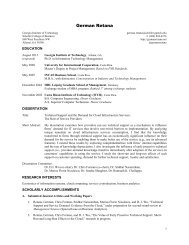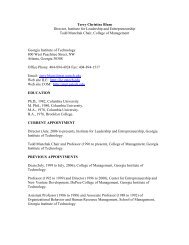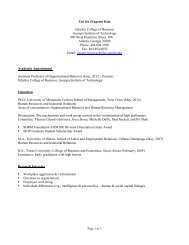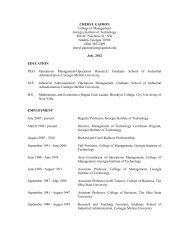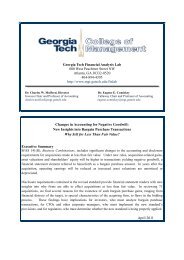Student Handbook - Georgia Tech - Georgia Institute of Technology
Student Handbook - Georgia Tech - Georgia Institute of Technology
Student Handbook - Georgia Tech - Georgia Institute of Technology
You also want an ePaper? Increase the reach of your titles
YUMPU automatically turns print PDFs into web optimized ePapers that Google loves.
III. <strong>Tech</strong>nology & Management CurriculumA. The sequence <strong>of</strong> classes in the “Non-Management <strong>Student</strong>s Only” category is flexible.However, it is highly desirable that all <strong>of</strong> these classes be completed before undertaking theT&M capstone project. The first two “Management <strong>Student</strong>s Only” classes, COE 3002 and ME3141, should be taken your first year in the program and are <strong>of</strong>fered only once a year. UsuallyCOE 3002 is <strong>of</strong>fered in the fall and ME 3141 in the spring, but the order may be reversed toaccommodate faculty schedules. “Management <strong>Student</strong>s Only” classes should be completedbefore the capstone project is undertaken. The T&M Together classes must be taken in the orderlisted unless special permission has been granted by the T&M Director.Non-MGT <strong>Student</strong>sOnlyMGT <strong>Student</strong>s OnlyTogetherFall Junior Year Marketing Mgt 1MGT 3300Spring Junior YearFall Senior YearFinancial andManagerialAccountingMGT 3000Finance andInvestmentsMGT 3078Introduction toMicroelectronics &Nanotechnology*COE 3002Cutting-EdgeEngineering SeminarME 3141Creative Decisions andDesignME 2110Analysis <strong>of</strong> Emerging<strong>Tech</strong>nologiesMGT or ME 3743*Managing Product,Service & <strong>Tech</strong>nologyDevelopmentMGT or ME 3744*Personal Leadership &Effective Teamwork -Capstone PreparationMGT or ME 4741Spring Senior YearIntegrated CapstoneProjectMGT or ME 4742*[4 hours credit]*Note: When registering for Together courses Engineering students must choose the MGT heading and Businessstudents must choose the ME heading5
B. Registration instructions for non-management students are stated in the following table. Please notethat students must notify the T&M Director their intent to register for one <strong>of</strong> MGT classes at least4 weeks prior to early registration.Required T&M Classes forT&M Non-MGT <strong>Student</strong>sRegistration Restrictions Other Restrictions Registration InstructionsMGT 3000, Financial &Managerial AccountingMGT 3078 Finance &InvestmentsMGT 3300 MarketingManagement IOnly non-managementmajors may registerOnly non-managementmajors may registerRestricted to managementmajors, but nonmanagementstudents mayregister with a permit. Youmust request a permit andregister during the first 11days (first phase) <strong>of</strong>registration.NoneNoneRestricted to students withJunior or Senior standing.Any student with fewer than60 hours must have a permitto override the classrestriction.Must register during earlyregistration. No permit isrequired, but contact T&MDirector if you are unable tosecure a seat in this class.Must register during earlyregistration. No permit isrequired, but contact T&MDirector if you are unable tosecure a seat in this classContact T&M Director atleast 4 weeks prior to earlyregistration with your plan toregister. A permit to registerduring early registration willbe issued. However, a permitis not needed after the 12 thday <strong>of</strong> the first phase <strong>of</strong>registration when degreemajor restrictions areremoved.C. Registration instructions for T&M management students are stated in the following table. Pleasenote that you’re required to take these classes in the sequence listed below unless specialcircumstances exist and permission is granted.Required T&M Classes forT&M Management<strong>Student</strong>sCOE 3002, Introduction tothe Microelectronics &Nanotechnology RevolutionME 3141, Cutting-EdgeEngineering SeminarME 2100 Creative Decisionsand DesignRegistration Restrictions Other Restrictions Registration InstructionsRegistration restricted, permitrequiredRegistration restricted, permitrequiredRestricted to ME majors, butmanagement students mayregister with a permit.Offered only once a year andusually in the fall semesterOffered only once a year andusually in the spring semester<strong>Student</strong>s should take thisclass during the fall semester<strong>of</strong> their Senior yearThe T&M <strong>of</strong>fice willautomatically request apermit for T&M students toregister. Must register duringearly registration toguarantee a seatThe T&M <strong>of</strong>fice willautomatically request apermit for T&M students toregister. Must register duringearly registration toguarantee a seatAll non-ME students need apermit to register during. TheT&M <strong>of</strong>fice willautomatically request apermit for you to register.Early registration required6
VI. New College <strong>of</strong> Management Concentration PoliciesA. Second minor or certificate: It is <strong>Georgia</strong> <strong>Tech</strong>’s policy that students may not use courses forone minor to fulfill requirements for any other minor or certificate at <strong>Georgia</strong> <strong>Tech</strong>, includingMGT certificates. Therefore, you may not use the E&M minor classes to fulfill requirementsfor any other minor or certificate. (Operations Management, ITM, and International Businesshave no overlapping requirements).B. However, College <strong>of</strong> Management students who are pursuing the E&M minor may use up to twoE&M courses towards MGT concentrations (but not towards certificates), as long as the E&Mcourse appears within the list <strong>of</strong> courses eligible for the concentration. When applying the E&Mcourses to the MGT concentrations, the courses may only be used once. For example, althoughMGT 3744 is listed under at least three different concentrations, students can only apply it to oneconcentration. E&M minor classes cannot be used to fulfill requirements for any othercertificate or minor at <strong>Tech</strong>, including MGT certificates.C. Eligibility for a concentration in the College <strong>of</strong> Management: In order to finish aconcentration in CoM, you must be a CoM student and change your major to Bachelor <strong>of</strong>Science in Business Administration (BSBA) degree after January 17, 2011. After the spring2011 graduating class, Bachelor <strong>of</strong> Science in Management students are not eligible to graduatewith concentrations. Learn more about the new BSBA degree and concentrations athttp://mgt.gatech.edu/programs/under/current/bsba_info.htmlD. Eligibility to finish a certificate in the College <strong>of</strong> Management: Any <strong>Georgia</strong> <strong>Tech</strong> studentcan complete a certificate in the CoM, including BSM and BSBA students. CoM students mayuse one class from a MGT concentration towards a MGT certificate. This can only occur ONCE.For instance, a student could use International Marketing towards a marketing concentrationAND the International Management certificate. If a student wanted to complete twoconcentrations and two certificates she could NOT exercise this policy twice. It can only be usedfor one course. <strong>Student</strong>s cannot earn a MGT certificate and concentration in the same area.Non-MGT students pursuing certificates cannot use the same class towards two certificates.Remember that E&M minor classes cannot be used to fulfill requirements for any other minor ora certificate at <strong>Tech</strong>, including MGT certificates.E. For continuing BS Management students: You can still use two <strong>of</strong> your E&M courses (up tosix credits) towards your Management electives. Because BSM students do not need to completea concentration, and instead must complete 18 credits <strong>of</strong> any MGT elective, you can use ME3743 and ME 3744 from the E&M minor towards their 18 credits <strong>of</strong> MGT electives. Anyremaining E&M minor classes may be used to fulfill the BSM non-MGT elective area (only thenon-MGT E&M courses) or the free elective area.Please see your Management advisor with specific questions:http://mgt.gatech.edu/programs/under/current/advising_registration/index.html8
your membership. This is an excellent way to stay connected with your fellow T&M studentswhile studying at <strong>Tech</strong>, interning, and even as alumni.VIII. Attendance & Pr<strong>of</strong>essional BehaviorA. Attendance Expectations: When you cannot attend a T&M class due to illness or a personalsituation, please email the faculty member teaching your T&M class and explain the situation. Youshould also insist on to making up the class content in a timely manner.B. Dress Code: For T&M classes, dress should be conservative and clean. For most events, the dresscode will be business casual; for some events, the dress code will be business formal and a suit willbe required. We will give you advance notice on the dress code for each event.C. Meeting Executives at T&M Events: You will have numerous opportunities to meet with highlevel corporate executives. The T&M Program requires you to prepare for these meetings byreviewing the bio <strong>of</strong> the individuals you will meet, studying the company’s web site to familiarizeyourself with their business, read recent news about their business, and study news sources forinformation about their industry. From these preparations, you should have 3 to 5 questions readyto ask the executives you will meet.D. Attendance at T&M Events: The T&M calendar will indicate whether an event is mandatory oroptional for your T&M class. RSVPs for all events are required 48 hours prior to the event.Cancellations after that time will be considered an unexcused absence. The T&M <strong>of</strong>fice willmaintain attendance records. There will be 6 mandatory extracurricular T&M events during theyear. You must attend at least 4 <strong>of</strong> the 6 events or you will be on probation status for theprogram the following semester. Under probation status, any additional unexcused absences willresult in dismissal from the program.E. Name Tents: At the beginning <strong>of</strong> the fall semester, you will receive a name tent. Please bring tentsto each T&M “together” class and display it prominently. It will help your instructor, fellowstudents, and visiting executives become familiar with your name.IX. Pr<strong>of</strong>essional Dress CodeA. T&M Classes: No special dress code is enforced for regular T&M classes (other than to beclean and put together). However, when corporate executives visit a T&M class, businesscasual attire is required. If you are presenting to executives, formal business attire (a suit) isrequired.B. T&M Events: Most T&M events will be lectures, workshops or informal social gatherings.Business casual clothing is appropriate. However, other events, including dinners with ourcorporate affiliates, require formal business attire.C. Formal Business Attire: For men, formal business attire is a suit, dress shoes, dress shirt andtie. For women, it is a suit or conservative dress (with sleeves or a jacket) and conservative(closed-toe) dress shoes.D. Descriptions for all dress codes are in Appendix 1.10
X. Performance Evaluation and Grading in T&M ClassesA. Performance Evaluation & Grading: Faculty expectations are higher in T&M classes than otherundergraduate classes. You were selected to join the T&M Program because <strong>of</strong> your talent, pastachievement and our belief you would perform in a mature, pr<strong>of</strong>essional manner in T&M classes.Active participation in classroom activities and team projects is a crucial part <strong>of</strong> yourevaluation and grade in T&M classes.B. Attendance: Many undergraduate classes do not stress attendance. However, attendance in theT&M Program is extremely important because participation is a critical aspect <strong>of</strong> T&M classes.You should share this information with your friends and family to dissuade them from arrangingsocial events that interfere with class attendance. If you must miss class, you must inform yourinstructor before the absence and make arrangements for making up the class content.XI.ReimbursementAll purchases must be approved by the Denning T&M Program Coordinator. All receipts forreimbursement must be submitted within 10 days <strong>of</strong> purchase. If you are in your Capstone Projectyear and require travel, let the T&M Program know as soon as possible and contact the ProgramCoordinator regarding reimbursement <strong>of</strong> travel expenses.XII. Conflict ResolutionIf you have a concern about a grade or faculty decision in a T&M class, we recommend you contact the<strong>Georgia</strong> <strong>Tech</strong> Ombuds Program at404-385-BUDS or(http://www.provost.gatech.edu/index.php?subject=ombuds§ion=index_content).The Ombuds Program is a confidential, neutral, informal and independent conflict resolution andmanagement resource open to assist any member <strong>of</strong> the <strong>Georgia</strong> <strong>Institute</strong> <strong>of</strong> <strong>Tech</strong>nology community.This Program's practices and procedures are guided by the Standards <strong>of</strong> Practice and Code <strong>of</strong> Ethicsestablished by the International Ombudsman Association (IOA). This <strong>of</strong>fice will help you handle thisissue in a pr<strong>of</strong>essional manner and you may also gain skills that will help you handle future conflict.XIII. Enrichment OpportunitiesThe T&M Program highly recommends you continue to develop your pr<strong>of</strong>essional skills outside theclassroom and outside the T&M Program. There are many social organizations and clubs that provideopportunities for skills enhancement. For example:• If your public speaking skills are weak, you might consider joining the <strong>Georgia</strong> <strong>Tech</strong> PublicSpeaking Club (contact them at psc@gatech.edu) or “<strong>Tech</strong>masters,” a Toastmasters-type group <strong>of</strong>feredon campus.• If you would like to improve your business communication and networking skills, theExecutive Round Table (ERT) is an excellent choice. This organization is an intellectual forum wherestudents, faculty and industry executives come together to pose solutions to issues facing ourcommunity. For membership information, contact: vp.student@gtert.org11
Business Formal Attire Guidelines:Appendix I. Dress CodeMen: A suit, dress shirt, tie, dark dress socks and dress shoes are required.Women: A suit with a conservative shirt, slacks, or plain skirt (no shorter than top <strong>of</strong> the knee) isrequired. You may also wear a business-looking dress with a suit jacket. Low-heeled dress shoes arerequired. Tops/shirts/blouses should be no more than 4 finger widths or 3 inches below the collarbone.Business Casual Attire Guidelines:Business casual indicates a crisp, neat, pr<strong>of</strong>essional look that would be appropriate even for a chancemeeting with a CEO. It should not look like you are going to a cocktail party or picnic. Avoid tight orbaggy clothing; business casual is classic rather than trendy.Basics: Khaki pants, neatly pressed, and a pressed long-sleeved, buttoned solid shirt are safe for bothmen and women. Polo/golf shirts, unwrinkled, are an appropriate choice if you know the environmentwill be quite casual, outdoors, or in a very hot location.Shoes / belt: Wear a leather belt and leather shoes. Athletic shoes are inappropriate.Cost / quality: You are not expected to be able to afford the same clothing as a corporateCEO. However, do invest in quality that will look appropriate during your first two or three years onthe job for a business casual environment or occasions.Details: Everything should be clean, well pressed, and not look worn. Even the nicest khakis after100 washings may not be your best choice for a reception. Carefully inspect new clothes for tags, andall clothes for dangling threads.Specifics for men's business casual dressTies: Ties are generally not necessary for business casual, but if you are in doubt, you can wear atie. It never hurts to slightly overdress; by dressing nicely, you pay a compliment to your host. Youcan always wear the tie and discreetly walk by the room where the function is held; if no one else iswearing a tie, you can remove yours.Shirts: Long-sleeved shirts are considered dressier than short-sleeved and are appropriate even insummer. Choosing white or solid, light blue, or conservative stripes is your safest bet. Polo shirts(tucked in, <strong>of</strong> course!) are acceptable in more casual situations.Socks: Wear dark, mid-calf length socks -- no skin should be visible when you sit down.Shoes: Leather shoes should be worn. No sandals, athletic shoes, or hiking boots.Facial hair: Just as with interviews, facial hair should be well-groomed. Know your industry andhow conservative it is; observe men in your industry if you are unsure what's appropriate or areconsidering changing your look.Jewelry: Wear a conservative watch. If you choose to wear other jewelry, beconservative. Remove your earrings! Executives in most industries don't wear earrings. Unless youplan to enter the entertainment or art field, earrings are a bad idea for men.12
Specifics for women's business casualDon't confuse club attire with business attire. If you would wear it to a club, you probably shouldn'twear it in a business environment.Pants / skirts: Women can wear casual pants or skirts. Neither should be tight. Fabrics should becrisp; colors should generally be solid such as navy, black, gray, brown and khaki.. For the mostbusiness-like appearance, pants should be creased and tailored; neither extremely tight nor baggy. Ifyou are pursuing a job in a conservative industry and are in doubt, observe well-dressed women inyour industry on the job, at career fairs, at information sessions, etc. Inappropriate slacks or pantsinclude jeans, sweatpants, exercise pants, Bermuda shorts, short shorts, shorts, bib overalls, leggings,and any spandex. Please avoid tight-fitting pants or low-rise pants. Pant waist should touch thetop <strong>of</strong> one’s hip bone---nothing lower! Shirts should fall 4 to 5 inches below the waist <strong>of</strong> the pants orhave a long shirt tail that is tucked into the pants. Skirts should touch the top <strong>of</strong> the knee.Skirt length and slits: Your skirt should come at least to your knees while you are standing. Whileyou are seated, your thighs should be covered. If your skirt comes to just below the knee, a slit to justabove the knee might be acceptable. A very long skirt should not be slit to above the knee. Generallyslits in the center back <strong>of</strong> a skirt — to facilitate walking or stair climbing — are acceptable. Slits t<strong>of</strong>acilitate a view <strong>of</strong> your legs are not appropriate for business purposes. Slips should not be visible.Short, tight skirts that ride halfway up the thigh are inappropriate for work. Mini-skirts, skorts, sundresses, beach dresses, and spaghetti-strap dresses are inappropriate for the <strong>of</strong>fice.Shirt / sweaters: In addition to tailored shirts or blouses, tailored knit sweaters and sweater sets areappropriate business casual choices for women. Cotton, silk, and blends are appropriate. Velvets andshimmery fabrics suitable for parties are not appropriate. Fit should not be tight. Cleavage is notappropriate to business and job search occasions. Avoid buttoned shirts that gap across the chest! Ifyou wear a shirt that buttons in the front, look in the mirror, stand up straight and open your arms.Does it gap across the chest? If it does, buy a larger shirt or wear a cami under the shirt to avoidflashing corporate executives. Do not wear low-cut tops! Necklines may come no lower than fourfingers or 3 inches below the collarbone.Jewelry / accessories: Wear a conservative watch. Jewelry and scarf styles come and go. Keepyour choices simple and leaning toward conservative. Avoid extremes <strong>of</strong> style and color. If yourindustry is creative, you may have more flexibility than someone pursuing a career in a conservativeindustry.Cosmetics: Keep makeup natural looking. A little is usually better than none for a polishedlook. Nails should be clean and well groomed. Avoid extreme nail length and polish color, especiallyin conservative industries.Shoes: Should be leather or fabric / micr<strong>of</strong>iber. Appropriate colors are black, navy and brown (tocoordinate with your other attire and accessories); white and pastels are not appropriate. For the mostconservative look, toes should be covered. Sandals which are neither extremely dressy nor extremelycasual might be appropriate. Thin straps, high heels, chunky heels, and/or platforms are notappropriate. Make certain you can walk comfortably in your shoe to convey a pr<strong>of</strong>essional image.Panty Hose: Not essential for business casual, but recommended if your skirt is knee length (ratherthan calf length) and in more formal environments.13
Purse / bag: If you carry a purse, keep it small and simple, or carry a small briefcase or businessliketote bag in place <strong>of</strong> a purse. A structured bag tends to look more pr<strong>of</strong>essional than something s<strong>of</strong>tor floppy. Purse/bag color should coordinate with your shoes or be a contrasting color, e.g., nude orcamel-colored bag with a dark suit). A briefcase is certainly not necessary for most business casualevents. Leather, micr<strong>of</strong>iber and fine woven fabrics are appropriate. Canvas and straw are notappropriate.Grooming tips for menShaving: Facial hair should be shaved the day you meet with corporate representatives. Two- orthree- day beards may be fashionable and popular with college students, but they are distracting andunacceptable to corporate executives and are judged unpr<strong>of</strong>essional.Grooming tips for men and womenHair & Hats: Hair should be clean, neat, and a natural color. Hats are not appropriate. However,head covers that are required for religious purposes or to honor cultural tradition are allowed.Tattoos and Piercings: Avoid any visible tattoos or piercings.Shoes: Should be in polished condition. Make sure heels are not worn.Clothing Details: No missing buttons, no lint; and don’t forget to remove external tags and tackingstitches from new clothes.Hands: Clean, trimmed fingernailsFit: Clothes should be clean, neatly pressed, and fit properly, neither tight nor baggy.Smell: Perfume or cologne should be used sparingly or not at all.No odors on clothes. Please use deodorant every day! Don't smell like smoke.Padfolios: Preferred over a bulky briefcase. A small briefcase is also appropriate, but if you have noreason to carry a briefcase, don't; you risk looking silly.Book bags: Appropriate to carry to an information session held on campus (after all, you are astudent). For career fairs and job fairs, book bags are generally checked at the door, and you shouldcarry a padfolio only. Don't carry a book bag to an event held <strong>of</strong>f campus.14


